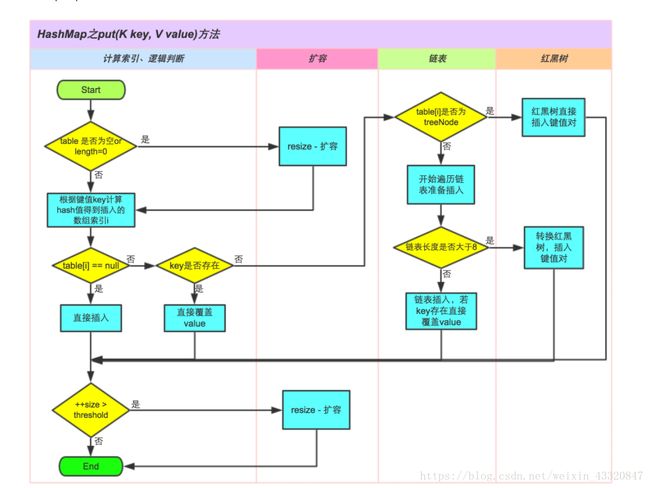HashMap 原理浅析
HashMap 可以说是使用频率相当频繁的一类 Java 容器了,它主要用来存放键值对
- name:张三
- age:18
HashMap 中可以存放 null,但 key 是唯一的,value 可以重复。当你将多个 key 相同的键值对存储进 HashMap 中时,只会显示最后放的键值对数据。
HashMap 是无序的,也就是说当你遍历 HashMap 时,得到的顺序和一开始存放的顺序是不同的。为什么不同呢?因为 HashMap 采用的是哈希存储的方式。
在用到哈希的数据结构中,比如 HashMap ,hash 值(key)存在的目的是加速键值对的查找,key 的作用是为了将元素适当地放在各个桶(bucket)里,这里的桶可以理解为数组的位置。
存储的过程如下:
- 定义一个初始数组
- 通过 hash 算法计算 key 的 hash 值
- 将键值对存储到数组中,hash 值即为数组下标
- 如果当前位置已有元素,采用链表的形式,将该键值对添加到原有元素的后面
- 若链表长度大于等于8,链表转为用红黑树存储
下面分步进行说明(基于JDK1.9)。
构造函数
在我们使用 HashMap 的时候,我们一般是采用无参构造函数:
/**
* Constructs an empty HashMap with the default initial capacity
* (16) and the default load factor (0.75).
*/
public HashMap() {
this.loadFactor = DEFAULT_LOAD_FACTOR; // all other fields defaulted
}
可以看到,这种情况下,都使用的是默认值,负载因子(default load factor)为0.75,初始数组大小(table)为16。
这里解释一下什么是负载因子:
负载因子 = 阈值/数组长度
阈值(threshold)就是你最多可以存储多少对
负载因子体现了对时间和空间的一种考量,负载因子越小,扩容就越频繁,所需空间就越大。一般使用默认值即可。
当然,HashMap 也提供了有参构造函数让我们更改默认的数组初始容量(initialCapacity)和默认负载因子。
put() 方法
public V put(K key, V value) {
return putVal(hash(key), key, value, false, true);
}
看起来很多参数,但我们只需要关注 hash(key) 方法与 putVal() 方法就可以了。
static final int hash(Object key) {
int h;
return (key == null) ? 0 : (h = key.hashCode()) ^ (h >>> 16);
}
key.hashCode() 方法返回的是 int 型数值,移位与异或的目的是增加 hashcode 值的随机性。
下面是关键代码:
final V putVal(int hash, K key, V value, boolean onlyIfAbsent,
boolean evict) {
Node<K,V>[] tab; Node<K,V> p; int n, i;
// 原有的数组是否为空,为空则新建一个数组
if ((tab = table) == null || (n = tab.length) == 0)
n = (tab = resize()).length;
// 如果数组对应下标的位置上没有Node节点(键值对)
if ((p = tab[i = (n - 1) & hash]) == null)
// 将该节点放置在此处
tab[i] = newNode(hash, key, value, null);
else {
Node<K,V> e; K k;
// 如果数组对应下标的位置上已有节点且该节点key值与要添加的key值相等,则覆盖原有节点
if (p.hash == hash &&
((k = p.key) == key || (key != null && key.equals(k))))
e = p;
// 如果该节点为TreeNode类型节点,采用红黑树存储
else if (p instanceof TreeNode)
e = ((TreeNode<K,V>)p).putTreeVal(this, tab, hash, key, value);
else {
// 当binCount达到一定大小,将链表转为红黑树
for (int binCount = 0; ; ++binCount) {
// 如果下一个节点为空直接存储
if ((e = p.next) == null) {
p.next = newNode(hash, key, value, null);
if (binCount >= TREEIFY_THRESHOLD - 1) // -1 for 1st
treeifyBin(tab, hash);
break;
}
// 如果下一个节点不为空,比较key值是否相等
if (e.hash == hash &&
((k = e.key) == key || (key != null && key.equals(k))))
break;
// 查询下一个节点
p = e;
}
}
if (e != null) { // existing mapping for key
V oldValue = e.value;
// onlyIfAbsent表示是否替换原有的值,true则不替换已存在的值
if (!onlyIfAbsent || oldValue == null)
e.value = value;
afterNodeAccess(e);
return oldValue;
}
}
// 记录HashMap内部结构发生变化的次数
++modCount;
// 当数组大小超过阈值,对数组进行扩容
if (++size > threshold)
resize();
afterNodeInsertion(evict);
return null;
}
在第二个 if 语句中有一个与操作 (n - 1) & hash,因为数组的大小为2的幂,假设为2的3次方,则 n - 1 的结果化为二进制为111 ,与操作相当于取 hash 的低三位,这样做的目的是使结果在数组的表示范围内,以免发生数组越界异常。
可以结合下图来理解(参考Java 8系列之重新认识 HashMap https://tech.meituan.com/java-hashmap.html)
resize() 方法
resize() 方法设计的也很巧妙。因为每次扩容数组长度都变为原来的两倍,以二进制来说相当于左移一位,则对于 table.length & hash 来说,结果比原来增加了一位。
比如原来数组的长度为4,hash 值的最后8位为00001010,原来计算的结果为10;当数组长度增加一倍后,计算的结果为010,增加了一位。
final Node<K,V>[] resize() {
Node<K,V>[] oldTab = table;
int oldCap = (oldTab == null) ? 0 : oldTab.length;
int oldThr = threshold;
int newCap, newThr = 0;
if (oldCap > 0) {
if (oldCap >= MAXIMUM_CAPACITY) {
threshold = Integer.MAX_VALUE;
return oldTab;
}
else if ((newCap = oldCap << 1) < MAXIMUM_CAPACITY &&
oldCap >= DEFAULT_INITIAL_CAPACITY)
// double threshold
newThr = oldThr << 1;
}
else if (oldThr > 0) // initial capacity was placed in threshold
newCap = oldThr;
else {
// zero initial threshold signifies using defaults
newCap = DEFAULT_INITIAL_CAPACITY;
newThr = (int)(DEFAULT_LOAD_FACTOR * DEFAULT_INITIAL_CAPACITY);
}
if (newThr == 0) {
float ft = (float)newCap * loadFactor;
newThr = (newCap < MAXIMUM_CAPACITY && ft < (float)MAXIMUM_CAPACITY ?
(int)ft : Integer.MAX_VALUE);
}
threshold = newThr;
@SuppressWarnings({"rawtypes","unchecked"})
Node<K,V>[] newTab = (Node<K,V>[])new Node[newCap];
table = newTab;
if (oldTab != null) {
for (int j = 0; j < oldCap; ++j) {
Node<K,V> e;
if ((e = oldTab[j]) != null) {
oldTab[j] = null;
if (e.next == null)
newTab[e.hash & (newCap - 1)] = e;
else if (e instanceof TreeNode)
((TreeNode<K,V>)e).split(this, newTab, j, oldCap);
else {
// 数组扩容后,元素要不在原来位置,要不平移2的指数个位置
Node<K,V> loHead = null, loTail = null;// 原来位置
Node<K,V> hiHead = null, hiTail = null;// 平移后位置
Node<K,V> next;
do {
next = e.next;
// 这里只需要与原数组长度做与运算,不需要减1
if ((e.hash & oldCap) == 0) {
if (loTail == null)
loHead = e;
else
loTail.next = e;
loTail = e;
}
else {
if (hiTail == null)
hiHead = e;
else
hiTail.next = e;
hiTail = e;
}
} while ((e = next) != null);
if (loTail != null) {
loTail.next = null;
newTab[j] = loHead;
}
if (hiTail != null) {
hiTail.next = null;
newTab[j + oldCap] = hiHead;
}
}
}
}
}
return newTab;
}
get() 方法
public V get(Object key) {
Node<K,V> e;
return (e = getNode(hash(key), key)) == null ? null : e.value;
}
final Node<K,V> getNode(int hash, Object key) {
Node<K,V>[] tab; Node<K,V> first, e; int n; K k;
if ((tab = table) != null && (n = tab.length) > 0 &&
(first = tab[(n - 1) & hash]) != null) {
// 因为key和k都有可能为null,其实这里可以用Objects.equals(k,key)更为简洁
if (first.hash == hash && // always check first node
((k = first.key) == key || (key != null && key.equals(k))))
return first;
if ((e = first.next) != null) {
if (first instanceof TreeNode)
return ((TreeNode<K,V>)first).getTreeNode(hash, key);
do {
if (e.hash == hash &&
((k = e.key) == key || (key != null && key.equals(k))))
return e;
} while ((e = e.next) != null);
}
}
return null;
}
- 红黑树部分待后续研究。
